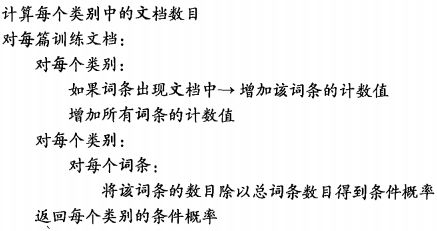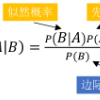# -*-coding:utf-8 -*-
'''
'''
from numpy import *
def loadDataSet():
'''
postingList: 进行词条切分后的文档集合
classVec:类别标签
'''
postingList=[['my', 'dog', 'has', 'flea', 'problems', 'help', 'please'],
['maybe', 'not', 'take', 'him', 'to', 'dog', 'park', 'stupid'],
['my', 'dalmation', 'is', 'so', 'cute', 'I', 'love', 'him'],
['stop', 'posting', 'stupid', 'worthless', 'garbage'],
['mr', 'licks', 'ate', 'my', 'steak', 'how', 'to', 'stop', 'him'],
['quit', 'buying', 'worthless', 'dog', 'food', 'stupid']]
classVec = [0,1,0,1,0,1] #1代表侮辱性文字,0代表正常言论
return postingList,classVec
def createVocabList(dataSet):
vocabSet = set([])#使用set创建不重复词表库
for document in dataSet:
vocabSet = vocabSet | set(document) #创建两个集合的并集
return list(vocabSet)
def setOfWords2Vec(vocabList, inputSet):
returnVec = [0]*len(vocabList)#创建一个所包含元素都为0的向量
#遍历文档中的所有单词,如果出现了词汇表中的单词,则将输出的文档向量中的对应值设为1
for word in inputSet:
if word in vocabList:
returnVec[vocabList.index(word)] = 1
else: print("the word: %s is not in my Vocabulary!" % word)
return returnVec
'''
我们将每个词的出现与否作为一个特征,这可以被描述为词集模型(set-of-words model)。
如果一个词在文档中出现不止一次,这可能意味着包含该词是否出现在文档中所不能表达的某种信息,
这种方法被称为词袋模型(bag-of-words model)。
在词袋中,每个单词可以出现多次,而在词集中,每个词只能出现一次。
为适应词袋模型,需要对函数setOfWords2Vec稍加修改,修改后的函数称为bagOfWords2VecMN
'''
def bagOfWords2VecMN(vocabList, inputSet):
returnVec = [0]*len(vocabList)
for word in inputSet:
if word in vocabList:
returnVec[vocabList.index(word)] += 1
return returnVec
def trainNB0(trainMatrix,trainCategory):
'''
朴素贝叶斯分类器训练函数(此处仅处理两类分类问题)
trainMatrix:文档矩阵
trainCategory:每篇文档类别标签
'''
numTrainDocs = len(trainMatrix)
numWords = len(trainMatrix[0])
pAbusive = sum(trainCategory)/float(numTrainDocs)
#初始化所有词出现数为1,并将分母初始化为2,避免某一个概率值为0
p0Num = ones(numWords); p1Num = ones(numWords)#
p0Denom = 2.0; p1Denom = 2.0 #
for i in range(numTrainDocs):
if trainCategory[i] == 1:
p1Num += trainMatrix[i]
p1Denom += sum(trainMatrix[i])
else:
p0Num += trainMatrix[i]
p0Denom += sum(trainMatrix[i])
#将结果取自然对数,避免下溢出,即太多很小的数相乘造成的影响
p1Vect = log(p1Num/p1Denom) #change to log()
p0Vect = log(p0Num/p0Denom) #change to log()
return p0Vect,p1Vect,pAbusive
def classifyNB(vec2Classify, p0Vec, p1Vec, pClass1):
'''
分类函数
vec2Classify:要分类的向量
p0Vec, p1Vec, pClass1:分别对应trainNB0计算得到的3个概率
'''
p1 = sum(vec2Classify * p1Vec) + log(pClass1)
p0 = sum(vec2Classify * p0Vec) + log(1.0 - pClass1)
if p1 > p0:
return 1
else:
return 0
def testingNB():
listOPosts,listClasses = loadDataSet()
myVocabList = createVocabList(listOPosts)
trainMat=[]
for postinDoc in listOPosts:
trainMat.append(setOfWords2Vec(myVocabList, postinDoc))
#训练模型,注意此处使用array
p0V,p1V,pAb = trainNB0(array(trainMat),array(listClasses))
testEntry = ['love', 'my', 'dalmation']
thisDoc = array(setOfWords2Vec(myVocabList, testEntry))
print(testEntry,'classified as: ',classifyNB(thisDoc,p0V,p1V,pAb))
testEntry = ['stupid', 'garbage']
thisDoc = array(setOfWords2Vec(myVocabList, testEntry))
print(testEntry,'classified as: ',classifyNB(thisDoc,p0V,p1V,pAb))
def textParse(bigString):#
'''
文本切分
输入文本字符串,输出词表
'''
import re
listOfTokens = re.split(r'\W*', bigString)
return [tok.lower() for tok in listOfTokens if len(tok) > 2]
def spamTest():
'''
垃圾邮件测试函数
'''
docList=[]; classList = []; fullText =[]
for i in range(1,26):
#读取垃圾邮件
wordList = textParse(open('email/spam/%d.txt' % i,'r',encoding= 'utf-8').read())
docList.append(wordList)
fullText.extend(wordList)
#设置垃圾邮件类标签为1
classList.append(1)
wordList = textParse(open('email/ham/%d.txt' % i,'r',encoding= 'utf-8').read())
docList.append(wordList)
fullText.extend(wordList)
classList.append(0)
vocabList = createVocabList(docList)#生成次表库
trainingSet = list(range(50))
testSet=[] #
#随机选10组做测试集
for i in range(10):
randIndex = int(random.uniform(0,len(trainingSet)))
testSet.append(trainingSet[randIndex])
del(trainingSet[randIndex])
trainMat=[]; trainClasses = []
for docIndex in trainingSet:#生成训练矩阵及标签
trainMat.append(bagOfWords2VecMN(vocabList, docList[docIndex]))
trainClasses.append(classList[docIndex])
p0V,p1V,pSpam = trainNB0(array(trainMat),array(trainClasses))
errorCount = 0
#测试并计算错误率
for docIndex in testSet:
wordVector = bagOfWords2VecMN(vocabList, docList[docIndex])
if classifyNB(array(wordVector),p0V,p1V,pSpam) != classList[docIndex]:
errorCount += 1
print("classification error",docList[docIndex])
print('the error rate is: ',float(errorCount)/len(testSet))
#return vocabList,fullText
def calcMostFreq(vocabList,fullText):
'''
返回前30个高频词
'''
import operator
freqDict = {}
for token in vocabList:
freqDict[token]=fullText.count(token)
sortedFreq = sorted(freqDict.items(), key=operator.itemgetter(1), reverse=True)
return sortedFreq[:30]
'''
函数localWords()与程序清单中的spamTest()函数几乎相同,区别在于这里访问的是
RSS源而不是文件。然后调用函数calcMostFreq()来获得排序最高的30个单词并随后将它们移除
'''
def localWords(feed1,feed0):
import feedparser
docList=[]; classList = []; fullText =[]
minLen = min(len(feed1['entries']),len(feed0['entries']))
for i in range(minLen):
wordList = textParse(feed1['entries'][i]['summary'])
docList.append(wordList)
fullText.extend(wordList)
classList.append(1) #NY is class 1
wordList = textParse(feed0['entries'][i]['summary'])
docList.append(wordList)
fullText.extend(wordList)
classList.append(0)
vocabList = createVocabList(docList)#create vocabulary
top30Words = calcMostFreq(vocabList,fullText) #remove top 30 words
for pairW in top30Words:
if pairW[0] in vocabList: vocabList.remove(pairW[0])
trainingSet = list(range(2*minLen)); testSet=[] #create test set
for i in range(10):
randIndex = int(random.uniform(0,len(trainingSet)))
testSet.append(trainingSet[randIndex])
del(trainingSet[randIndex])
trainMat=[]; trainClasses = []
for docIndex in trainingSet:#train the classifier (get probs) trainNB0
trainMat.append(bagOfWords2VecMN(vocabList, docList[docIndex]))
trainClasses.append(classList[docIndex])
p0V,p1V,pSpam = trainNB0(array(trainMat),array(trainClasses))
errorCount = 0
for docIndex in testSet: #classify the remaining items
wordVector = bagOfWords2VecMN(vocabList, docList[docIndex])
if classifyNB(array(wordVector),p0V,p1V,pSpam) != classList[docIndex]:
errorCount += 1
print('the error rate is: ',float(errorCount)/len(testSet))
return vocabList,p0V,p1V
def getTopWords(ny,sf):
import operator
vocabList,p0V,p1V=localWords(ny,sf)
topNY=[]; topSF=[]
for i in range(len(p0V)):
if p0V[i] > -6.0 : topSF.append((vocabList[i],p0V[i]))
if p1V[i] > -6.0 : topNY.append((vocabList[i],p1V[i]))
sortedSF = sorted(topSF, key=lambda pair: pair[1], reverse=True)
print("SF**SF**SF**SF**SF**SF**SF**SF**SF**SF**SF**SF**SF**SF**SF**SF**")
for item in sortedSF:
print(item[0])
sortedNY = sorted(topNY, key=lambda pair: pair[1], reverse=True)
print("NY**NY**NY**NY**NY**NY**NY**NY**NY**NY**NY**NY**NY**NY**NY**NY**")
for item in sortedNY:
print(item[0])
if __name__== "__main__":
testingNB()
#导入RSS数据源
# import operator
# ny=feedparser.parse('http://newyork.craigslist.org/stp/index.rss')
# sf=feedparser.parse('http://sfbay.craigslist.org/stp/index.rss')
# localWords(ny,sf)






